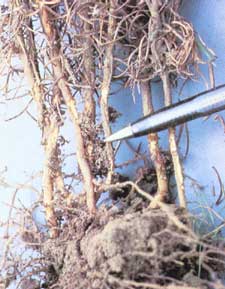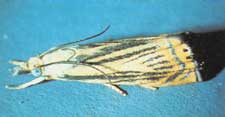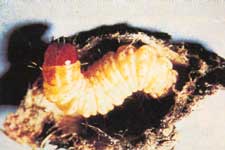Cranberry GirdlerDavid L. Overhulser - Principal Entomologist, Oregon Department of Forestry, Salem, OR, and Cordell C.E., Anderson R.L., Hoffard W.H., Landis T.D., Smith R.S. Jr., Toko H.V., 1989. Forest Nursery Pests. USDA Forest Service, Agriculture Handbook No. 680, 184 pp. Hosts The cranberry girdler (Crysoteuchia topiaria) commonly damages 2-0 nursery stock of Douglas-fir, noble fir, larch, and spruce. Other stock occasionally damaged include 1-0, 3-0, and 2-1 Douglas-fir and 1-0 larch. Distribution The cranberry girdler has been observed in bareroot conifer nurseries in Oregon, Washington, and Idaho. Damage
Biology Adult moths (Fig. 28-2) emerge in grass fields from May to July. Moths are visible during the day. They fly in quick, jerky movements for short distances. Female moths deposit eggs on and around nursery stock. Eggs hatch in 3 to 5 days, and larvae (Fig. 28-3) feed in nursery beds from June to October, when they spin the cocoons where they overwinter. What damages seedlings is feeding by the late instars in August to October. Moth populations vary from year to year because of the effects of predation and disease on larval survival. Birds such as starlings, killdeer, sandpipers, and blackbirds feed on overwintering larvae. A naturally occurring soil fungus, Beauveria bassiana, also kills overwintering larvae. Control Cultural - Avoid using cover crops that might provide host material for the cranberry girdler or other sod webworms. Cultivate or apply herbicides to noncrop areas to control weeds and grasses. Chemical - Traps baited with an attractant and placed in grassy areas adjacent to the nursery can be used to monitor populations and to time insecticide applications for moth control. Applying diazinon to nursery beds 3 and 5 weeks after the start of moth flight reduced seedling damage. Additional seedling protection is obtained by soil applications of chlorpyrifos in August and September. Selected References Kamm, J. A.; Robinson, R. R. 1974. Life history and control of sod webworm in grass seed production. Ext. Circ. 851. Corvallis, OR: Oregon State University Extension Service. 2 p. Kamm, J. A.; Morgan, P. D.; Overhulser, D. L. [and others]. 1983. Management practices for cranberry girdler (Lepidoptera: Pyralidae) in Douglas-fir nursery stock. Journal of Economic Entomology. 76: 923-926. Tunnock, S. 1985. Suppression of cranberry girdler damage in beds of Douglas-fir seedlings, Coeur d'Alene Nursery, Idaho Panhandle National Forest. Rep. 85-4. Missoula, MT: U.S. Department of Agriculture, Forest Service, Northern Region. 7 p. |
Forest Pests: Insects, Diseases & Other Damage Agents |

|
|




